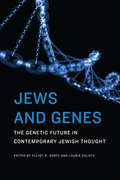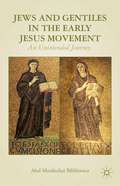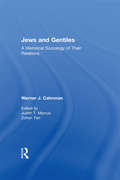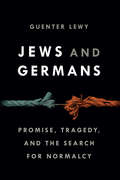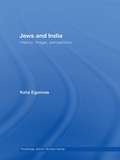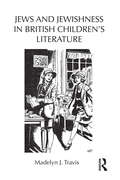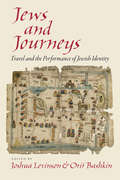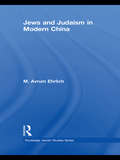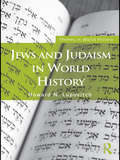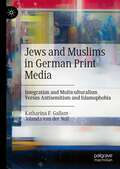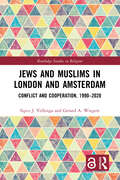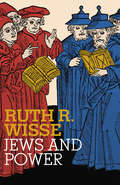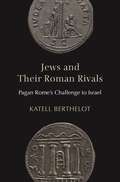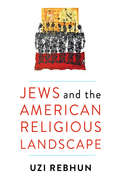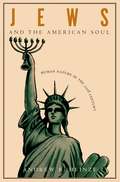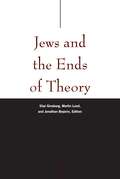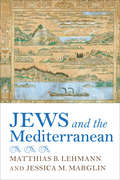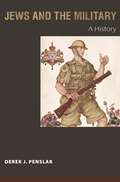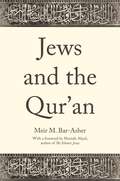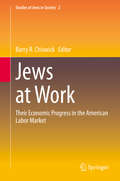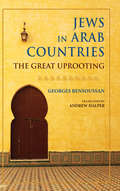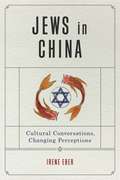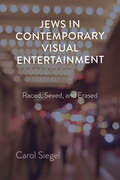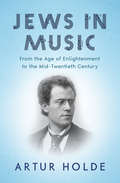- Table View
- List View
Jews and Genes: The Genetic Future in Contemporary Jewish Thought
by Rabbi Elliot N. Dorff Dr Laurie ZolothWell aware of Jews having once been the victims of Nazi eugenics policies, many Jews today have an ambivalent attitude toward new genetics and are understandably wary of genetic forms of identity and intervention. At the same time, the Jewish tradition is strongly committed to medical research designed to prevent or cure diseases. Jews and Genes explores this tension against the backdrop of various important developments in genetics and bioethics—new advances in stem cell research; genetic mapping, identity, testing, and intervention; and the role of religion and ethics in shaping public policy. Jews and Genes brings together leaders in their fields, from all walks of Judaism, to explore these most timely and intriguing topics—the intricacies of the genetic code and the wonders of life, along with cutting-edge science and the ethical issues it raises.
Jews and Gentiles in the Early Jesus Movement
by Abel Mordechai BibliowiczThis volume offers new insights on Jewish-Gentile relations and the evolution of belief in the early Jesus movement, suggesting that the New Testament reflects the early stages of a Gentile challenge to the authority and legitimacy of the descendants of Jesus' disciples and first followers as the exclusive guardians and interpreters of his legacy.
Jews and Gentiles: A Historical Sociology of Their Relations
by Werner J. Cahnman"Studies of the Jewish experience among peoples with whom they live share some similarities with the usual histories of anti-Semitism, but also some differences. When the focus is on anti-Semitism, Jewish history appears as a record of unmitigated hostility against the Jewish people and of passivity on their part. However, as Werner J. Cahnman demonstrates in this posthumous volume, Jewish-Gentile relations are far more complex. There is a long history of mutual contacts, positive as well as antagonistic, even if conflict continues to require particular attention.Cahnman's approach, while following a historical sequence, is sociological in conception. From Roman antiquity through the Middle Ages, into the era of emancipation and the Holocaust, and finally to the present American and Israeli scene, there are basic similarities and various dissimilarities, all of which are described and analyzed. Cahnman tests the theses of classical sociology implicitly, yet unobtrusively. He traces the socio-economic basis of human relations, which Marx and others have emphasized, and considers Jews a ""marginal trading people"" in the Park-Becker sense. Simmel and Toennies, he shows, understood Jews as ""strangers"" and ""intermediaries."" While Cahnman shows that Jews were not ""pariahs,"" as Max Weber thought, he finds a remarkable affinity to Weber's Protestantism-capitalism argument in the tension of Jewish-Christian relations emerging from the bitter theological argument over usury.The primacy of Jewish-Gentile relations in all their complexity and variability is essential for the understanding of Jewish social and political history. This volume is a valuable contribution to that understanding."
Jews and Germans: Promise, Tragedy, and the Search for Normalcy
by Guenter LewyJews and Germans is the only book in English to delve fully into the history and challenges of the German-Jewish relationship, from before the Holocaust to the present day. The Weimar Republic era—the fifteen years between Germany&’s defeat in World War I (1918) and Hitler&’s accession (1933)—has been characterized as a time of unparalleled German-Jewish concord and collaboration. Even though Jews constituted less than 1 percent of the German population, they occupied a significant place in German literature, music, theater, journalism, science, and many other fields. Was that German-Jewish relationship truly reciprocal? How has it evolved since the Holocaust, and what can it become? Beginning with the German Jews&’ struggle for emancipation, Guenter Lewy describes Jewish life during the heyday of the Weimar Republic, particularly the Jewish writers, left-wing intellectuals, combat veterans, and adult and youth organizations. With this history as a backdrop he examines the deeply disparate responses among Jews when the Nazis assumed power. Lewy then elucidates Jewish life in postwar West Germany; in East Germany, where Jewish communists searched for a second German-Jewish symbiosis based on Marxist principles; and finally in the united Germany—illuminating the complexities of fraught relationships over time.
Jews and India: Perceptions and Image (Routledge Jewish Studies Series)
by Yulia EgorovaExploring the image of Jews in India in the nineteenth and twentieth centuries, this book looks at both the Indian attitudes towards the Jewish communities of the subcontinent and at the way Jews and Judaism in general have been represented in Indian discourse. Despite the fact that the Indian Jewish population constitutes one of the country’s tiniest minorities, the relations of the local Jews with other communities form an integral part in the history of Indian multiculturalism. This has become increasingly apparent over the last two centuries as Judaism and its image have been incorporated into the discussions of some of the most prominent figures of different religious and nationalist movements, leaders of independent India, and the Indian mass media. Furthermore, recent decades witnessed mass adoption of Israelite identity by Indians from two different regions and religious groups. Being a topic that has received little attention, Jews and India seeks to rectify this situation by examining these developments and providing a fascinating insight into these issues. This volume will be of interest to scholars of Jewish and Indian cultural studies.
Jews and Jewishness in British Children's Literature (Children's Literature and Culture)
by Madelyn TravisIn a period of ongoing debate about faith, identity, migration and culture, this timely study explores the often politicised nature of constructions of one of Britain’s longest standing minority communities. Representations in children’s literature influenced by the impact of the Enlightenment, the Empire, the Holocaust and 9/11 reveal an ongoing concern with establishing, maintaining or problematising the boundaries between Jews and Gentiles. Chapters on gender, refugees, multiculturalism and historical fiction argue that literature for young people demonstrates that the position of Jews in Britain has been ambivalent, and that this ambivalence has persisted to a surprising degree in view of the dramatic socio-cultural changes that have taken place over two centuries. Wide-ranging in scope and interdisciplinary in approach, Jews and Jewishness in British Children’s Literature discusses over one hundred texts ranging from picture books to young adult fiction and realism to fantasy. Madelyn Travis examines rare eighteenth- and nineteenth-century material plus works by authors including Maria Edgeworth, E. Nesbit, Rudyard Kipling, Richmal Crompton, Lynne Reid Banks, Michael Rosen and others. The study also draws on Travis’s previously unpublished interviews with authors including Adele Geras, Eva Ibbotson, Ann Jungman and Judith Kerr.
Jews and Journeys: Travel and the Performance of Jewish Identity (Jewish Culture and Contexts)
by Joshua Levinson and Orit BashkinJourneys of dislocation and return, of discovery and conquest hold a prominent place in the imagination of many cultures. Wherever an individual or community may be located, it would seem, there is always the dream of being elsewhere. This has been especially true throughout the ages for Jews, for whom the promises and perils of travel have influenced both their own sense of self and their identity in the eyes of others.How does travel writing, as a genre, produce representations of the world of others, against which one's own self can be invented or explored? And what happens when Jewish authors in particular—whether by force or of their own free will, whether in reality or in the imagination—travel from one place to another? How has travel figured in the formation of Jewish identity, and what cultural and ideological work is performed by texts that document or figure specifically Jewish travel? Featuring essays on topics that range from Abraham as a traveler in biblical narrative to the guest book entries at contemporary Israeli museum and memorial sites; from the marvels medieval travelers claim to have encountered to eighteenth-century Jewish critiques of Orientalism; from the Wandering Jew of legend to one mid-twentieth-century Yiddish writer's accounts of his travels through Peru, Jews and Journeys explores what it is about travel writing that enables it to become one of the central mechanisms for exploring the realities and fictions of individual and collective identity.
Jews and Judaism in Modern China (Routledge Jewish Studies Series)
by M. Avrum EhrlichJews and Judaism in Modern China explores and compares the dynamics at work in two of the oldest, intact and starkly contrasting civilizations on earth; Jewish and Chinese. The book studies how they interact in modernity and how each civilization views the other, and analyses areas of cooperation between scholars, activists and politicians. Through evaluation of the respective talents, qualities and social assets that are fused and borrowed in the civilizational exchange, we gain an insight into the social processes underpinning two contrasting and long surviving civilizations. Identifying and analysing some of the emerging current issues, this book suggests Jewish-Chinese relations may become a growing discipline of import to the study of religion and comparative identity, and looks at how the significant contrasts in Jewish and Chinese national constructs may serve them well in the quest for a meaningful discourse. Chapters explore identity, integrity of the family unit; minority status; religious freedom; ethics and morality; tradition versus modernity; the environment, and other areas which are undergoing profound transformation. Identifying the intellectual and practical nexus and bifurcation between the two cultures, worldviews and identities, this work is indispensable for students of Chinese studies, sociology, religion and the Jewish diaspora, and provides useful reading for Western tourists to China.
Jews and Judaism in World History (Themes in World History)
by Howard N. LupovitchThis book is a survey of the history of the Jewish people from biblical antiquity to the present, spanning nearly 2,500 years and traversing five continents. Opening with a broad introduction which addresses key questions of terminology and definition, the book’s ten chapters then go on to explore Jewish history in both its religious and non-religious dimensions. The book explores the social, political and cultural aspects of Jewish history, and examines the changes and continuities across the whole of the Jewish world throughout its long and varied history. Topics covered include: the emergence of Judaism as a religion and way of life the development during the Middle Ages of Judaism as an all-encompassing identity the effect on Jewish life and identity of major changes in Europe and the Islamic world from the mid sixteenth through the end of the nineteenth century the complexity of Jewish life in the twentieth century, the challenge of anti-semitism and the impact of the Holocaust, and the emergence of the current centres of World Jewry in the State of Israel and the New World.
Jews and Muslims in German Print Media: Integration and Multiculturalism Versus Antisemitism and Islamophobia
by Katharina F. Gallant Jolanda van der NollThis book uses a comparative research design to analyze the reporting on the Jewish minority and the Muslim minority in German newspapers from 2010-2019, asking whether minorities are truly treated as equals in the reporting of the mainstream German media. After providing historical and socio-political context for both groups as minority populations in Germany, the authors make use of qualitative and quantitative methods to examine sentiment and determine whether the media demonstrates a unifying or a well-differentiated portrayal of the two groups. The findings show that reporting on these groups is not as unbiased as many in Germany believe. Drawing on frameworks including the needs-based model of reconciliation, the revised integrated threat theory, and the model of acculturation strategies, the book then discusses the implications for both journalistic reporting and broader social policies in support of a constructive encounter of dominant andnon-dominant groups in a diverse society. This book will be of interest to scholars and students in the field of migration, integration and intergroup relations, as well as those in communication, media studies, and discourse analysis.
Jews and Muslims in London and Amsterdam: Conflict and Cooperation, 1990-2020 (Routledge Studies in Religion)
by Sipco J. Vellenga Gerard A. WiegersThis book focuses on the development of bilateral Jewish-Muslim relations in London and Amsterdam since the late-1980s. It offers a comparative analysis that considers both similarities and differences, drawing on historical, social scientific, and religious studies perspectives. The authors address how Jewish-Muslim relations are related to the historical and contemporary context in which they are embedded, the social identity strategies Jews and Muslims and their institutions employ, and their perceived mutual positions in terms of identity and power. The first section reflects on the history and current profile of Jewish and Muslim communities in London and Amsterdam and the development of relations between Jews andMuslims in both cities. The second section engages with sources of conflict and cooperation. Four specific areas that cause tension are explored: the Israeli-Palestinian conflict; antisemitism and Islamophobia; attacks by extremists; and the commemoration of wars and genocides. In addition to ‘trigger events’, what stands out is the influence of historical factors, public opinion, the ‘mainstream’ Christian churches and the media, along with the role of government. The volume will be of interest to scholars from fields including religious studies, interfaith studies, Jewish studies, Islamic studies, urban studies, European studies, and social sciences as well as members of the communities concerned, other religious communities, journalists, politicians, and teachers who are interested in Jewish-Muslim relations.
Jews and Power (Jewish Encounters Series)
by Ruth R. WisseTaking in everything from the Kingdom of David to the Oslo Accords, Ruth Wisse offers a radical new way to think about the Jewish relationship to power. Traditional Jews believed that upholding the covenant with God constituted a treaty with the most powerful force in the universe; this later transformed itself into a belief that, unburdened by a military, Jews could pursue their religious mission on a purely moral plain. Wisse, an eminent professor of comparative literature at Harvard, demonstrates how Jewish political weakness both increased Jewish vulnerability to scapegoating and violence, and unwittingly goaded power-seeking nations to cast Jews as perpetual targets. Although she sees hope in the State of Israel, Wisse questions the way the strategies of the Diaspora continue to drive the Jewish state, echoing Abba Eban's observation that Israel was the only nation to win a war and then sue for peace. And then she draws a persuasive parallel to the United States today, as it struggles to figure out how a liberal democracy can face off against enemies who view Western morality as weakness. This deeply provocative book is sure to stir debate both inside and outside the Jewish world. Wisse's narrative offers a compelling argument that is rich with history and bristling with contemporary urgency. From the Hardcover edition.
Jews and Their Roman Rivals: Pagan Rome's Challenge to Israel
by Katell BerthelotHow encounters with the Roman Empire compelled the Jews of antiquity to rethink their conceptions of Israel and the TorahThroughout their history, Jews have lived under a succession of imperial powers, from Assyria and Babylonia to Persia and the Hellenistic kingdoms. Jews and Their Roman Rivals shows how the Roman Empire posed a unique challenge to Jewish thinkers such as Philo, Josephus, and the Palestinian rabbis, who both resisted and internalized Roman standards and imperial ideology.Katell Berthelot traces how, long before the empire became Christian, Jews came to perceive Israel and Rome as rivals competing for supremacy. Both considered their laws to be the most perfect ever written, and both believed they were a most pious people who had been entrusted with a divine mission to bring order and peace to the world. Berthelot argues that the rabbinic identification of Rome with Esau, Israel's twin brother, reflected this sense of rivalry. She discusses how this challenge transformed ancient Jewish ideas about military power and the use of force, law and jurisdiction, and membership in the people of Israel. Berthelot argues that Jewish thinkers imitated the Romans in some cases and proposed competing models in others.Shedding new light on Jewish thought in antiquity, Jews and Their Roman Rivals reveals how Jewish encounters with pagan Rome gave rise to crucial evolutions in the ways Jews conceptualized the Torah and conversion to Judaism.
Jews and the American Religious Landscape: A Comparative Study
by Uzi RebhunJews and the American Religious Landscape explores major complementary facets of American Judaism and Jewish life through a comprehensive analysis of contemporary demographic and sociological data. Focusing on the most important aspects of social development—geographic location, socioeconomic stratification, family dynamics, group identification, and political orientation—the volume adds empirical value to questions concerning the strengths of Jews as a religious and cultural group in America and the strategies they have developed to integrate successfully into a Christian society.With advanced analyses of data gathered by the Pew Research Center, Jews and the American Religious Landscape shows that Jews, like other religious and ethnic minorities, strongly identify with their religion and culture. Yet their particular religiosity, along with such factors as population dispersion, professional networks, and education, have created different outcomes in various contexts. Living under the influence of a Christian majority and a liberal political system has also cultivated a distinct ethos of solidarity and egalitarianism, enabling Judaism to absorb new patterns in ways that mirror its integration into American life. Rich in information thoughtfully construed, this book presents a remarkable portrait of what it means to be an American Jew today.
Jews and the American Soul: Human Nature in the Twentieth Century
by Andrew R. HeinzeWhat do Joyce Brothers and Sigmund Freud, Rabbi Harold Kushner and philosopher Martin Buber have in common? They belong to a group of pivotal and highly influential Jewish thinkers who altered the face of modern America in ways few people recognize. So argues Andrew Heinze, who reveals in rich and unprecedented detail the extent to which Jewish values, often in tense interaction with an established Christian consensus, shaped the country's psychological and spiritual vocabulary. Jews and the American Soul is the first book to recognize the central role Jews and Jewish values have played in shaping American ideas of the inner life. It overturns the widely shared assumption that modern ideas of human nature derived simply from the nation's Protestant heritage. Heinze marshals a rich array of evidence to show how individuals ranging from Erich Fromm to Ann Landers changed the way Americans think about mind and soul. The book shows us the many ways that Jewish thinkers influenced everything from the human potential movement and pop psychology to secular spirituality. It also provides fascinating new interpretations of Sigmund Freud, Alfred Adler, and Western views of the psyche; the clash among Protestant, Catholic, and Jewish moral sensibilities in America; the origins and evolution of America's psychological and therapeutic culture; the role of Jewish women as American public moralists, and more. A must-read for anyone interested in the contribution of Jews and Jewish culture to modern America.
Jews and the Ends of Theory
by Shai Ginsburg, Martin Land, and Jonathan BoyarinTheory, as it’s happened across the humanities, has often been coded as “Jewish.” This collection of essays seeks to move past explanations for this understanding that rely on the self-evident (the historical centrality of Jews to the rise of Critical Theory with the Frankfurt School) or stereotypical (psychoanalysis as the “Jewish Science”) in order to show how certain problematics of modern Jewishness enrich theory.In the range of violence and agency that attend the appellation “Jew,” depending on how, where, and by whom it’s uttered, we can see that Jewishness is a rhetorical as much as a sociological fact, and that its rhetorical and sociological aspects, while linked, are not identical. Attention to this disjuncture helps to elucidate the questions of power, subjectivity, identity, figuration, language, and relation that modern theory has grappled with. These questions in turn implicate geopolitical issues such as the relation of a people to a state and the violence done in the name of simplistic identitarian ideologies.Clarifying a situation where “the Jew” is not readily or unproblematically legible, the editors propose what they call “spectral reading,” a way to understand Jewishness as a fluid and rhetorical presence. While not divorced from sociological facts, this spectral reading works in concert with contemporary theory to mediate pessimistic and utopian impulses, experiences, and realities.Contributors: Svetlana Boym, Andrew Bush, Sergey Dolgopolski, Jay Geller, Sarah Hammerschlag, Hannan Hever, Martin Land, Martin Jay, James I. Porter, Yehouda Shenhav, Elliot R. Wolfson
Jews and the Mediterranean (Sephardi And Mizrahi Studies)
by Matthias B. Lehmann Jessica M. MarglinA selection of essays examining the significance of what Jewish history and Mediterranean studies contribute to our knowledge of the other.Jews and the Mediterranean considers the historical potency and uniqueness of what happens when Sephardi, Mizrahi, and Ashkenazi Jews meet in the Mediterranean region. By focusing on the specificity of the Jewish experience, the essays gathered in this volume emphasize human agency and culture over the length of Mediterranean history. This collection draws attention to what made Jewish people distinctive and warns against facile notions of Mediterranean connectivity, diversity, fluidity, and hybridity, presenting a new assessment of the Jewish experience in the Mediterranean.
Jews and the Military: A History
by Derek J. PenslarA historical reevaluation of the relationship between Jews, miltary service, and warJews and the Military is the first comprehensive and comparative look at Jews' involvement in the military and their attitudes toward war from the 1600s until the creation of the state of Israel in 1948. Derek Penslar shows that although Jews have often been described as people who shun the army, in fact they have frequently been willing, even eager, to do military service, and only a minuscule minority have been pacifists. Penslar demonstrates that Israel's military ethos did not emerge from a vacuum and that long before the state's establishment, Jews had a vested interest in military affairs.Spanning Europe, North America, and the Middle East, Penslar discusses the myths and realities of Jewish draft dodging, how Jews reacted to facing their coreligionists in battle, the careers of Jewish officers and their reception in the Jewish community, the effects of World War I on Jewish veterans, and Jewish participation in the Spanish Civil War and World War II. Penslar culminates with a study of Israel's War of Independence as a Jewish world war, which drew on the military expertise and financial support of a mobilized, global Jewish community. He considers how military service was a central issue in debates about Jewish emancipation and a primary indicator of the position of Jews in any given society.Deconstructing old stereotypes, Jews and the Military radically transforms our understanding of Jews' historic relationship to war and military power.
Jews and the Qur'an
by Meir M. Bar-AsherA compelling book that casts the Qur’anic encounter with Jews in an entirely new lightIn this panoramic and multifaceted book, Meir Bar-Asher examines how Jews and Judaism are depicted in the Qur’an and later Islamic literature, providing needed context to those passages critical of Jews that are most often invoked to divide Muslims and Jews or to promote Islamophobia. He traces the Qur’anic origins of the protection of Jews and other minorities living under the rule of Islam, and shows how attitudes toward Jews in Shi‘i Islam are substantially different from those in Sunni Islam. Bar-Asher sheds light on the extraordinary contribution of Jewish tradition to the Muslim exegesis of the Qur’an, and draws important parallels between Jewish religious law, or halakha, and shari‘a law.An illuminating work on a topic of vital relevance today, Jews and the Qur’an offers a nuanced understanding of Islam’s engagement with Judaism in the time of Muhammad and his followers, and serves as a needed corrective to common misperceptions about Islam.
Jews at Work: Their Economic Progress in the American Labor Market (Studies of Jews in Society #2)
by Barry R. ChiswickThis book addresses the educational, occupational, and income progress of Jews in the American labor market. Using theoretical and statistical findings, it compares the experience of American Jews with that of other Americans, from the middle of the 19th century through the 20th and into the early 21st century.Jews in the United States have been remarkably successful; from peddlers and low-skilled factory workers, clearly near the bottom of the economic ladder, they have, as a community, risen to the top of the economic ladder. The papers included in this volume, all authored or co-authored by Barry Chiswick, address such issues as the English language proficiency, occupational attainment and earnings of Jews, educational and labor market discrimination against Jews, life cycle and labor force participation patterns of Jewish women, and historical and methodological issues, among many others. The final chapter analyzes alternative explanations for the consistently high level of educational and economic achievement of American Jewry over the past century and a half. The chapters in this book also develop and demonstrate the usefulness of alternative techniques for identifying Jews in US Census and survey data where neither religion nor Jewish ethnicity is explicitly identified. This methodology is also applicable to the study of other minority groups in the US and in other countries.
Jews in Arab Countries: The Great Uprooting (Studies in Antisemitism)
by Georges BensoussanIn this new history, French author Georges Bensoussan retells the story of what life was like for Jews in the Arab world since 1850. During the early years of this time, it was widely believed that Jewish life in Arab lands was peaceful. Jews were protected by law and suffered much less violence, persecution, and inequality. Bensoussan takes on this myth and looks back over the history of Jewish-Arab relations in Arab countries. He finds that there is little truth to the myth and forwards a nuanced history of interrelationship that is not only diverse, but deals with local differences in cultural, religious, and political practice. Bensoussan divides the work into sections that cover 1850 to the end of WWI, from 1919 to the eve of WWII and then from WWII to the establishment of Israel and the Arab Wars. A new afterword brings the history of Jewish and Arab relations into the present day. Bensoussan has determined that the history of Jews in Arab countries is a history of slowly disintegrating relationships, increasing tension, violence, and persecution.
Jews in China: Cultural Conversations, Changing Perceptions (Dimyonot)
by Irene EberIrene Eber was one of the foremost authorities on Jews in China during the twentieth and twenty-first centuries—a field that, in contrast to the study of the Jewish diaspora in Europe and the Americas, has been critically neglected. This volume gathers fourteen of Eber’s most salient articles and essays on the exchanges between Jewish and Chinese cultures, making available to students, scholars, and general readers a representative sample of the range and depth of her important work in the field of Jews in China.Jews in China delineates the centuries-long, reciprocal dialogue between Jews, Jewish culture, and China, all under the overarching theme of cultural translation. The first section of the book sets forth a sweeping overview of the history of Jews in China, beginning in the twelfth century and concluding with a detailed assessment of the two crucial years leading up to the Second World War. The second section examines the translation of Chinese classics into Hebrew and the translation of the Hebrew Bible into Chinese. The third and final section turns to modern literature, bringing together eight essays that underscore the cultural reciprocity that takes place through acts of translation.The centuries-long relationship between Judaism and China is often overlooked in the light of the extensive discourse surrounding European and American Judaism. With this volume, Eber reminds us that we have much to learn from the intersections between Jewish identity and Chinese culture.
Jews in China: Cultural Conversations, Changing Perceptions (Dimyonot: Jews and the Cultural Imagination #7)
by Irene EberIrene Eber was one of the foremost authorities on Jews in China during the twentieth and twenty-first centuries—a field that, in contrast to the study of the Jewish diaspora in Europe and the Americas, has been critically neglected. This volume gathers fourteen of Eber’s most salient articles and essays on the exchanges between Jewish and Chinese cultures, making available to students, scholars, and general readers a representative sample of the range and depth of her important work in the field of Jews in China.Jews in China delineates the centuries-long, reciprocal dialogue between Jews, Jewish culture, and China, all under the overarching theme of cultural translation. The first section of the book sets forth a sweeping overview of the history of Jews in China, beginning in the twelfth century and concluding with a detailed assessment of the two crucial years leading up to the Second World War. The second section examines the translation of Chinese classics into Hebrew and the translation of the Hebrew Bible into Chinese. The third and final section turns to modern literature, bringing together eight essays that underscore the cultural reciprocity that takes place through acts of translation.The centuries-long relationship between Judaism and China is often overlooked in the light of the extensive discourse surrounding European and American Judaism. With this volume, Eber reminds us that we have much to learn from the intersections between Jewish identity and Chinese culture.
Jews in Contemporary Visual Entertainment: Raced, Sexed, and Erased
by Carol SiegelWhat are the consequences of how Jews are depicted in movies and television series? Drawing on a host of movies and television series from the 1970s to present day, Jews in Contemporary Visual Entertainment explores how the media sexualize and racialize American Jews. Race and sexuality frequently intersect in the depiction of Jewish characters in such shows as The Marvelous Mrs. Maisel, UnREAL, The Expanse, and Breaking Bad, and in films such as Hester Street, Once Upon a Time in America, Casino, Radio Days, Inglourious Basterds, and Barton Fink. When they do, American sexual norms are invariably challenged or outright broken by these anti-Semitic representations of Jewishness.Insightful and provocative, Jews in Contemporary Visual Entertainment disturbingly reveals the far-reaching influence of popular visual media in shaping how American Jews are perceived today.
Jews in Music: From the Age of Enlightenment to the Mid-Twentieth Century
by Artur HoldeThis authoritative history chronicles the work and lives of great Jewish musicians around the world from the early nineteenth century to the mid-twentieth. Since the Age of Enlightenment, Jewish musicians, composers, and musicologists have greatly enriched the artistic legacies of cultures and countries on a global scale. Their contributions have been a major influence on numerous musical forms, both secular and sacred. Jews in Music presents a survey of these accomplishments through the rise of Zionism, the settlement of the Jewish Homeland, and the burgeoning Jewish music developments in America.Jews in Music presents a detailed history ranging from the symphonies of Felix Mendelssohn to the Broadway musicals of Leonard Bernstein, from the great touring violinists of Western Europe to the pioneers of commercial music recording. Plus, a section on sacred music explores in depth the evolution of the musical components of the synagogue, including the chants, compositions, and traditional songs of the chazzanim.
